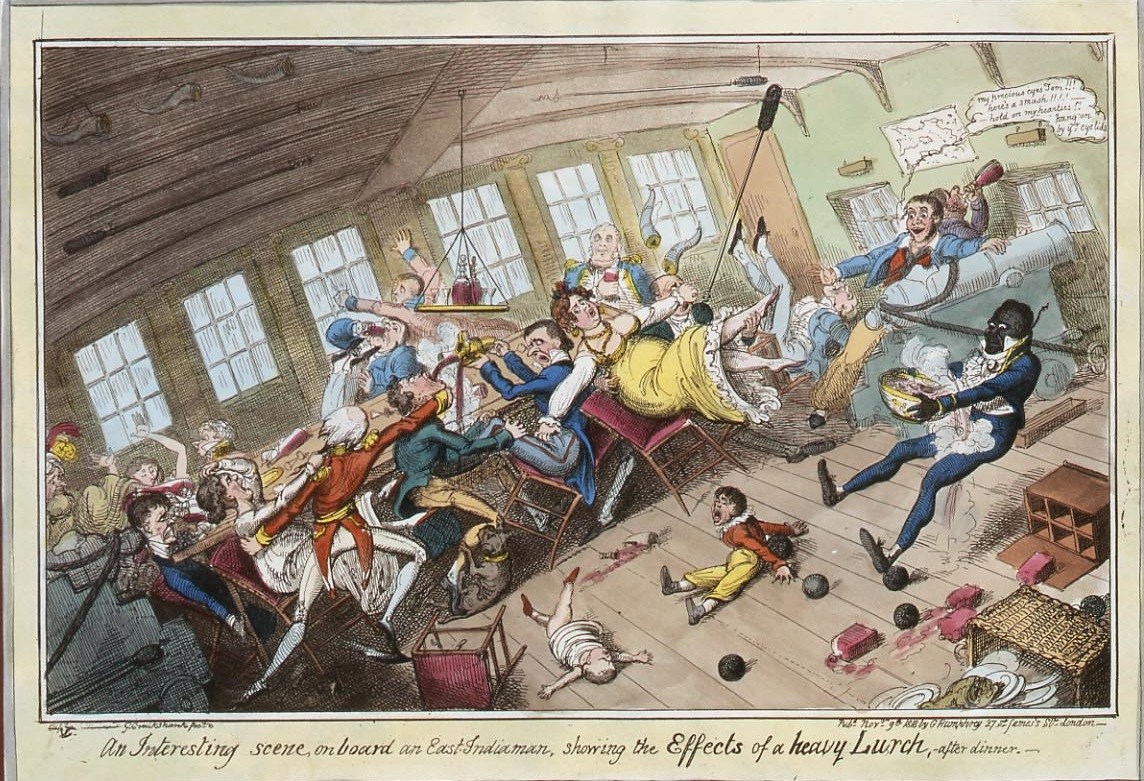
‘An interesting scene on board an East-Indiaman, showing the effects of a heavy lurch, after dinner’ by George Cruikshank, 1818
Currently on display in the museum’s latest exhibition, East of India – Forgotten trade with Australia
ANMM Collection
‘“Make us laugh or you starve—Give us fresh fun; we have eaten up the old and are hungry”’
~ William Makepeace Thackeray, 1840
In his work, An essay on the genius of George Cruikshank, the English novelist William Makepeace Thackeray wrote in admiration for one of the most famous illustrators of his day. Thackeray was trying to convey how a ‘greedy public’ has ‘bought, borrowed or stole’ a ‘heap of personal kindnesses from George Cruikshank’ and therefore owed a great deal to the caricaturist. In a way, one of Cruikshank’s ‘kindnesses’, an engraving from the museum’s collection, portrays the essence of what Thackeray was trying to say. The themes of greed, fickleness and arrogance highlighted by Thackeray, are illustrated brilliantly in Cruikshank’s caricature which is currently on display in the museum’s latest exhibition, East of India – Forgotten trade with Australia.
Among Thackeray’s many descriptions of Cruikshank there’s one which seems to stand out as particularly ironic. Labelled a ‘humble scraper on steel’, there’s nothing modest or self-deprecating about the way that Cruikshank chooses to portray his subjects and themes. The son of a caricaturist, Cruikshank became known for his sharp satirical illustrations and the engraving from the museum’s collection is no exception. Titled, ‘An interesting scene on board an East-Indiaman, showing the effects of a heavy lurch, after dinner’, the work depicts a grand cabin on board an English East India Company ship in complete disarray. The ‘lurch’ has caused the dining table to slide squashing one of the passengers against a cannon, other passengers and their servants are being tossed about and a member of the crew exclaims: ‘My precious eyes Tom!!! here’s a smash!!!! – hold on my hearties!! hang on by yr eyelids’. Published on 9 November 1818, it is one of his earlier works and illustrates what life may have been like on board an English East India Company ship, fighting the rough voyage across the Indian Ocean. Only the higher ranking passengers were allowed to dine in the more lavish cabins and we can see in Cruikshank’s illustration, through the exaggerated way he has chosen to depict his subjects, that he expresses this in a rather cynical way. Excess is a word that springs to mind and the contorted faces of each individual demonstrate the power of the grotesque in communicating a political point.
Cruikshank’s works achieved great success and were published widely throughout his career. They were a medium through which attitudes and themes could be translated to the masses in a way that was easy to understand. And what better way to do this than through illustration? As Thackeray notes in his essay, Cruikshank’s caricatures were essentially an expression of popular culture:
How we used to believe in them! to stray miles out of the way on holidays, in order to ponder for an hour before that delightful window in Sweeting’s Alley! in walks through Fleet Street, to vanish abruptly down Fairburn’s passage, and there make one at his “charming gratis” exhibition. There used to be a crowd round the window in those days, of grinning, good-natured mechanics, who spelt the songs, and spoke them out for the benefit of the company, and who received the points of humor with a general sympathizing roar. Where are these people now?
According to Thackeray, despite the caricaturist’s slight fall in popularity he had a ‘natural’ ability to connect with the ‘“little people”’ by creating art that imitated life. He noted that it took a degree of ‘honesty’ for Cruikshank to convey the messages featured in his caricatures and that he ‘would not for any bribe say what he did not think’. Yet despite his talent for telling ‘a thousand truths in as many strange and fascinating ways’, Cruikshank accepted a bribe of £100 from Kind George IV in 1820, ‘in consideration of a pledge not to caricature His Majesty in any immoral situation’.
All contradictions aside, what we are left with in the end is a clever social and political critique of life on board an English East India Company ship, displayed through the whimsical, chaotic and sardonic style of George Cruikshank.
East of India – Forgotten Trade with Australia is currently showing at the Australian National Maritime Museum until 18 August 2013. The exhibition tracks Australia’s colonial links with India, the power and monopoly of the English East India Company, and its decline.
Nicole Cama
Curatorial assistant
Useful links and further reading:
- William Makepeace Thackery, An essay on the genius of George Cruikshank, H Cooper: June 1840.
- Cyril Northcote Parkinson, Trade in the Eastern Seas, 1955.
- Engraving titled ‘Splendid Jem’ by Isaac Robert Cruikshank, George Cruikshank’s brother, also from the ANMM Collection.
